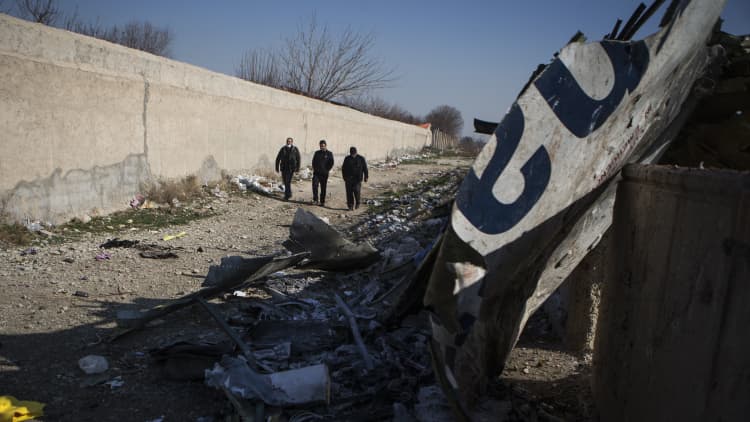
Kyiv-bound Ukraine International Flight 752 was on fire before it hit the ground outside of Tehran, killing all 176 people on board, Iranian officials said Thursday.
But little is known about what brought the plane down. Some aviation safety experts and pilots called several aspects of the incident unusual and because the crash occurred during heightened tensions between Iran and the U.S. information about the flight may remain scarce.
All 176 people — 167 passengers and nine crew — on the Boeing 737-800 were killed when it crashed two minutes after takeoff from Tehran. Video shared on social media showed what appeared to be the plane on fire, falling to the ground in a fireball outside of the Iranian capital. The plane had turned, apparently to return to the airport, Iran's civil aviation authority said, adding that there was no distress call.
The plane was not the 737 Max model that was grounded in March last year after two fatal crashes, but it adds to scrutiny on Boeing, which is scrambling to contain the fallout from those incidents.

The crash occurred hours after Iran launched retaliatory missile strikes on U.S. positions in Iraq for the killing of Gen. Qasem Soleimani, timing that prompted speculation that a stray Iranian missile may have downed the passenger plane. But as of Wednesday evening, there was no evidence to support that. Airlines began avoiding airspace in the region, taking other routes due to the conflict.
It can sometimes take investigators more than a year to determine the cause of a plane crash and getting information about the deadly incident has become more complicated. An Iranian official told local media the country wouldn't hand over the black boxes — which contain flight data and cockpit voice recordings — from the crash site to the U.S. or to Boeing for review.
Under international law, the country where the crash occurred controls the investigation. Because the plane was manufactured in the United States, Boeing, the Federal Aviation Administration and the National Transportation Safety Board would generally participate.
"The United States will continue to follow this incident closely and stands prepared to offer Ukraine all possible assistance," Secretary of State Mike Pompeo said in a statement Wednesday. "The United States calls for complete cooperation with any investigation into the cause of the crash."
Boeing offered its condolences to the victims and said it is "ready to assist in any way needed."
If Iranian officials withhold data, "they're not going to be trusted in our eyes and whatever they say without giving us the data, we're not going to believe," said John Goglia, a former NTSB member.
Iranian officials told local media that engine failure likely brought down the plane, but some doubted that explanation.
"It would would be a very rare set of circumstances where an engine failure would cause a plane to crash," said Goglia, who has investigated accidents including the July 1996 crash of TWA Flight 800 that killed all 230 people on board.
The engines were CFM56 models, one of the most commonly used engines in the world, made by a joint venture of General Electric and France's Safran.
Pilots undergo simulator training for those scenarios and on commercial flights can usually find a safe place to land the plane, aviation experts told CNBC, adding that engine failure breaking apart an entire plane is highly unlikely.
The crew was highly experienced, including a captain who had 11,600 hours of flight time on a Boeing 737 with 5,500 of those as a captain, according to the airline.
"Given the crew's experience, error probability is minimal," Ukraine International Airlines vice president of operations, Ihor Sosnovsky, said in a statement. "We do not even consider such a chance."
The Boeing 737-800 was in good condition and was serviced on Jan. 6, the airline said. It was delivered new to Ukraine International Airlines in 2016 and no problems had been recently reported, the company added.
The flight took off from Tehran's Imam Khomeini Airport at 6:12 a.m. and lost contact at 6:14 a.m., according to flight-tracking site Flightradar24. The airline said the plane reached about 2,400 meters, about 7,900 feet, which pilots and experts said was a normal altitude for that stage in the flight.
The abrupt cut to location data was peculiar, said Jeff Price, an aviation safety expert and a professor in the Department of aviation and aerospace science at Metropolitan State University of Denver, because when dealing with a mechanical failure, normally pilots would communicate with the airport and the plane would continue to transmit data.
"It just went dark," Price said. "It's just odd."



